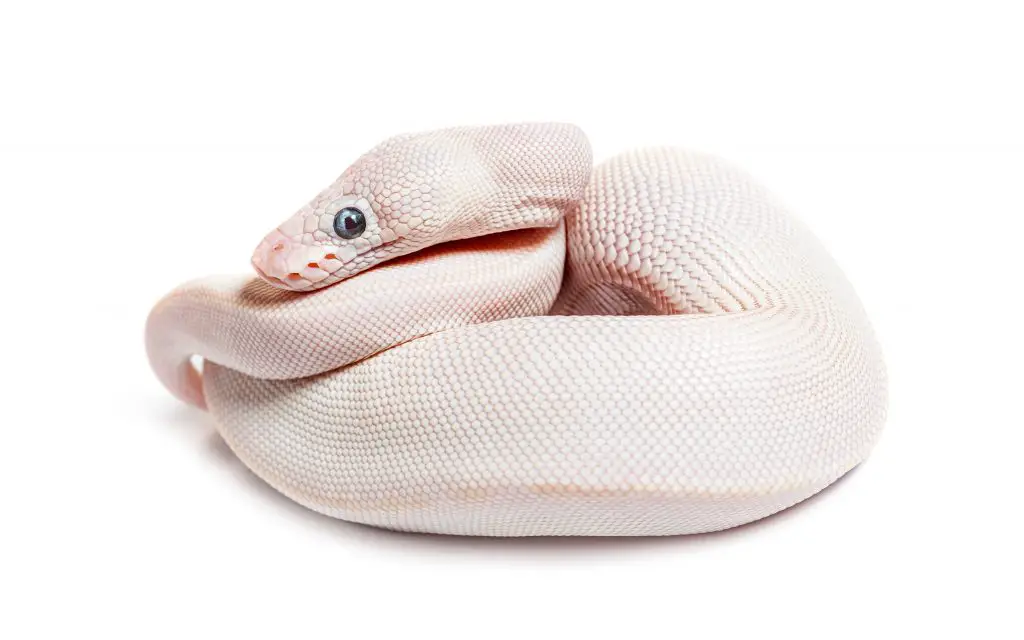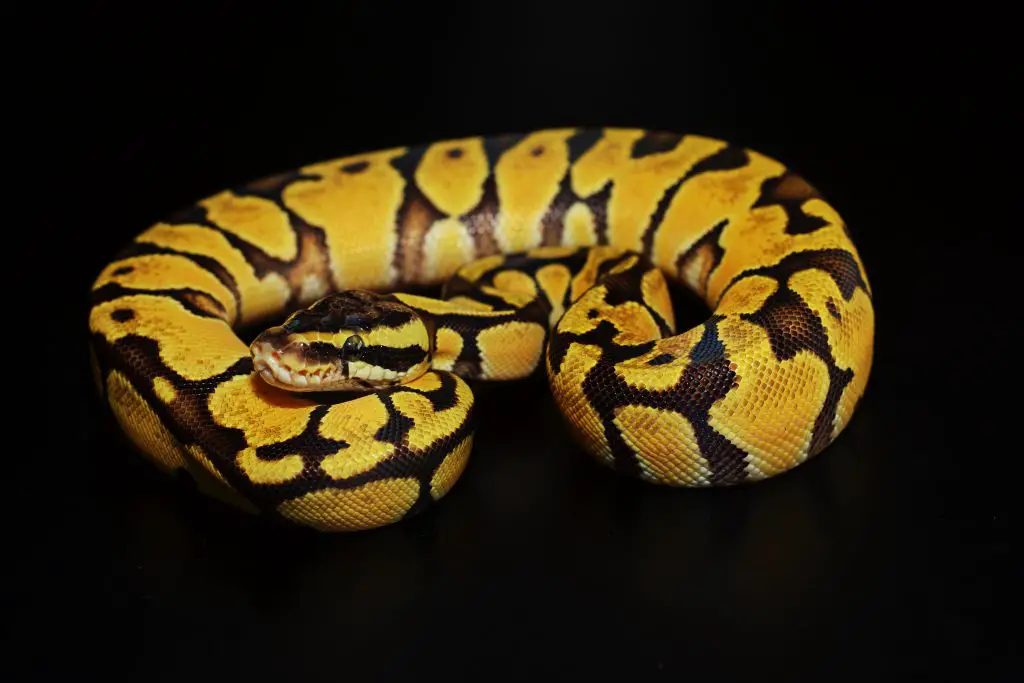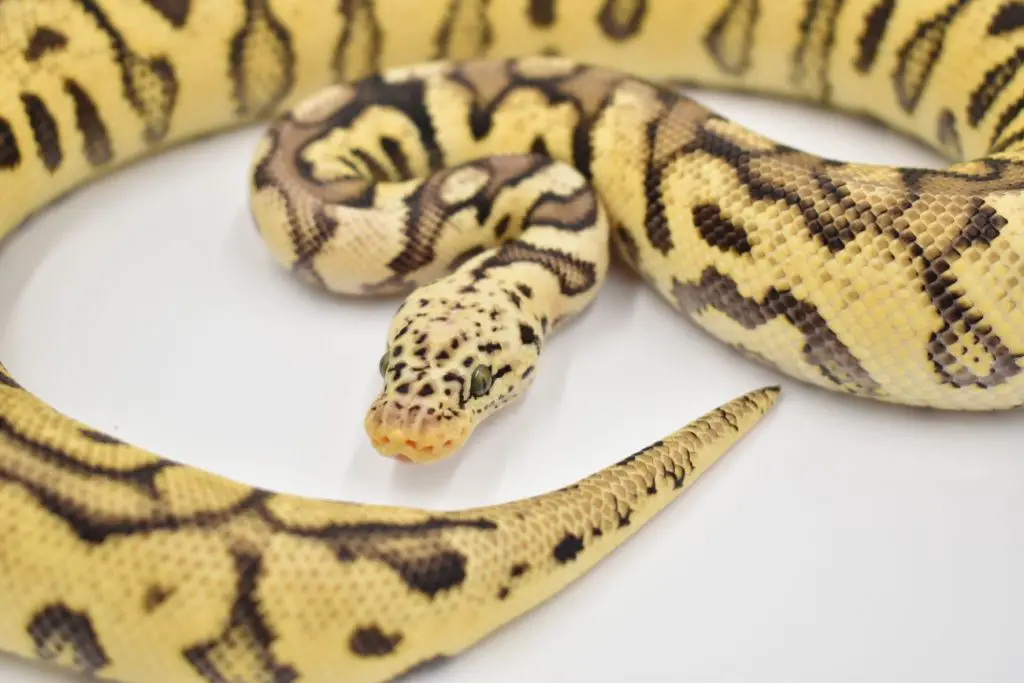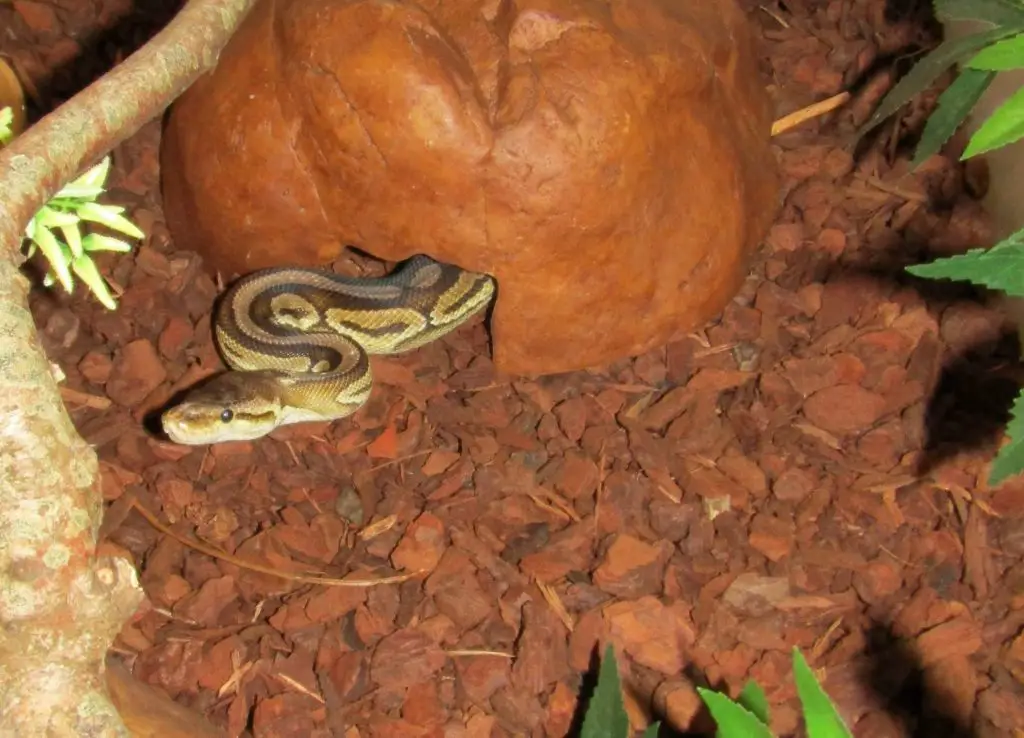The number one thing to remember when handling Ball Pythons is to be gentle. Pick them up by the body and support them fully with both hands so that they feel safe from falling. NEVER try to pick up a Ball Python by grabbing it behind the head: this is their pet hate!
In this post, I’m going to teach you how to handle Ball Pythons based on my experience with taming them over the years. If you follow these instructions, even the most nervous snake will eventually become completely docile.
How to handle a Ball Python for the first time or if it’s still a new pet
Before getting into this too deeply, let’s look at a few golden rules of snake handling, then we’ll look at handling Ball Pythons specifically. Follow these rules, and you’ll get along fine with most small-to-medium sized snakes.
1. Always approach from above – not on their level. Prey approaches on their level, and your fingers don’t want to be prey. This is more difficult with front-opening enclosures.
2. Pick them up from the body – not the head or the tail (unless dealing with a venomous species). Picking up harmless snakes by the head or tail will anger them at best, or hurt them at worst.
3. Never restrain them unless they are openly aggressive. Don’t restrain an animal unless necessary – treat them as innocent until proven bitey.
4. Don’t handle a new pet snake until it’s had its first meal, and a week to acclimatize to its new home. Moving is stressful, let a new snake adjust before adding more stress.
These rules apply to Ball Pythons just as much as they do to other species, but it’s particularly important to remember that they are head shy. This means touching them on the head or neck terrifies them.
You should always avoid touching a python’s head. In the wild, their head is their weak spot. It’s every animal’s neurological center, so predators always attack the head first. When you try to touch a Ball Python’s head, it makes it worry that you’re thinking about eating it!
To safely handle a Ball Python, follow these steps:
- Approach it slowly from above, at a time when it is exploring or resting – not when it’s waiting for a meal (when hungry, they wait at the entrance to their hiding place, with their neck coiled in an “s” shape)
- Gently grasp the upper and lower body with both hands. For large adults, try to scoop your hands underneath the body.
- Lift it out of the enclosure and keep the body supported at all times.
- For shy or new snakes, sit down on the floor or a couch, and let it rest on you until it starts to explore on its own.

Do Ball Pythons bite?
It’s incredibly rare that Ball Pythons bite. Generally speaking, it’s only either hatchlings or wild-caught ones that do so. Moreover, defensive or aggressive bites don’t really hurt. They’re kind of just a short tap, which draws blood, but leaves you thinking “that wasn’t that bad!”
When it comes down to it, the average owner is in fact unlikely to get bitten unless they are breeding these snakes, or regularly acquiring new ones. That said, if you keep snakes, you will eventually get bitten, just as sure as if you keep cats, you’ll eventually get scratched, or if you keep a Great Dane, it will eventually run into you while chasing a ball and knock you over.
This is where choosing the best beginner snakes gets important. Great first pet snake species like Ball Pythons, Corn Snakes, Rosy Boas, and King Snakes all have average or weak bites, whereas some advanced species like Reticulated Pythons have downright painful bites.

How to pacify an aggressive (defensive) Ball Python
Every once in a while, you get a grouchy baby Ball Python, or even an adult that hasn’t been handled much. They rear up in an “S,” hiss and launch some puny strikes at you.
Fortunately, this is easy to deal with. Because they are head-shy, they retreat and curl into a ball as soon as they start to lose a fight.
The best way to make a Ball Python thinks it’s picked on the wrong owner is what I call the “linen trick.” And yes, that’s a terrible name, but it’s effective.
Basically, when a Ball Python is acting defensive, you hold out a t-shirt or pillowcase with a pair of tongs and drop it onto the snake from above. 99 times out of 100 the snake will immediately curl up and retreat!
Now that its head-shyness has sent it into retreat mode, you can safely pick it up. It sounds odd, but it genuinely works.

Dealing with very shy hatchlings and juvenile snakes
Some Ball Pythons are exceptionally shy and can take weeks to come out of their shell. I’ve had this with several hatchlings over the years, and most recently with an incredibly beautiful Pastel Spotnose Clown that would not relax.
Instead, he balled up every time I got him out. The best way to deal with this is to handle the snake twice a week (slightly more often than most).
When you remove them and they ball up, place the snake on your lap with your hands laid flat, palms up near them. It might take 5, 10 or even 15 minutes, but eventually it will wonder what’s happening and come out to explore.
When it inevitably crawls over your hands, gently move them so that it gets used to crawling over your hand and through your fingers. If you do this for a few weeks – literally any shy baby Ball Python will become tame.

Can you handle Ball Pythons during the day?
You absolutely can handle Ball Pythons during the day. Especially if you are nervous or they have a history of being defensive.
Ball Pythons are nocturnal ambush hunters, so for them night-time is for hunting. Just look at Prince in the photo below that I snuck in the middle of the night – clearly not a good time to put your fingers in front of him!
During the day, Ball Pythons are sleepier, and more amenable to being handled. Moreover, being handled for 10 minutes isn’t going to ruin their whole day’s sleep.
All-in-all these snakes don’t seem to mind being bothered during the day, they’re incredibly docile and peaceful creatures after all.

Can you handle Ball Pythons too much?
Handling Ball Pythons too much is a common problem because it leads to stress. In this species, the stress response is particularly strong, but hard for us to notice because they rarely act outwardly aggressive.
If you handle your Ball Python too much, it might not give you any clues in terms of body language. What you may notice, though, is that it stops eating or even starts to regurgitate its food.
In general, it’s best to only handle adult snakes once a week, or twice at the most. Juveniles that are being tamed can be handled twice a week until they get used to it.

Do Ball Pythons like to be handled?
Not all Ball Pythons like to be handled. It’s a bit of a shame, but it’s true. Out of my pets, there’s only really one, Spirit, who genuinely seems to enjoy it, and has insatiable curiosity.
Others enjoy exploring, and my oldest male, Bobby, also enjoys periscoping and watching TV for periods of time. It’s not the handling he enjoys though, it’s simply that he feels a need to observe his wider territory.
Other Ball Pythons in my collection don’t like being held at all. Prince, who I’ve had almost as long as Bobby, hates being handled. There is zero chance of him sitting on my lap and watching TV like Bobby does.

Signs your handling technique is not the problem
If you have an oddly irritable Ball Python, don’t be too quick to blame your handling technique: especially if it was previously very laid-back. One thing that can influence a snake’s behaviour is stress, and this is Ball Python’s biggest weakness.
Signs that stress is at play include:
- restlessness 24/7
- refusing to feed
- regurgitation
- constantly trying to escape
- not trying to hide or sleep
Two of the main causes of stress are handling too often, and incorrect enclosure size. Handling too often is pretty easy to resolve – just take it down to once a week.
Enclosure size, on the other hand, can only be solved by moving the snake to a smaller enclosure or adding a lot of decorations to make its enclosure feel smaller. A lot of resources online tell you to give your snake a ridiculously large enclosure, mainly so that they can sell you those enclosures through affiliate links and make as much money as possible.
The thing is, Ball Pythons get incredibly stressed out in large enclosures, and the most common ways this manifests itself are through anorexia or unusually shy or defensive behaviour.
Notwithstanding, there are also rare individuals who are genetically predisposed to grouchiness, including some morphs. Many keepers say that the Spotnose morph is highly strung, and a few feel that Puzzle is too.
Occasionally, you get individuals of any morph that are grouchy though, and there’s not a lot you can do: it’s just how nature and genetic variation pan out sometimes.

Ball Python handling myths
While we’re here, I thought it would be a good idea to do some myth busting. As hard as some of us try, the myths keep multiplying – even when it comes to popular pet reptiles like the Ball Python!
Let’s take a quick glance at the top 4 Ball Python handling myths…
1.They will stop being tame if you don’t handle them enough
Literally one of the dumbest things I’ve heard so far. In case you haven’t seen how docile wild Ball Pythons are, head over to Dav Kaufman’s YouTube Channel and see for yourself. Your pet python won’t turn into a killer because it hasn’t seen you in a week!
2. They need to be handled several times a week for exercise
No, unlike sight predators (the Montpellier Snake, for example) ambush predators don’t need huge amounts of exercise. Handling too much is a bad idea due to the stress it causes. Once a week, for 5-10 minutes is great.
3. If you don’t wash your hands first, they’ll try to bite you
Again, not a very smart assumption. These snakes won’t smell their owner’s scent and think: dinner! They respond to the scent of rodents and to a lesser extent birds. Wash your hands if you’ve been handling these animals, if not – don’t sweat it.
4. You should hold them behind the head – like the guys on TV do
Ask yourself this question: do you need restraining by the neck every time you leave your home? Obviously not, and you probably wouldn’t appreciate it. The same thing goes for gentle, laid-back snakes like Ball Pythons.

Key points to remember about handling this species:
- Being gentle is the best way to tame them
- Always avoid touching a Ball Python’s head
- Never restrain them unless absolutely necessary
- Always support their body with both hands
- Try sitting down with nervous snakes, this is safer and makes them more relaxed
- Handle them during the day, not at feeding time (night-time)
- Adult Ball Pythons aren’t typically aggressive, and this could be a sign of a health problems like a respiratory infection
- Regular handling is only necessary for younger snakes, to get them tame. Adults can be handled as little as once a week or so, as they have no need for social interaction
- A safe space, fresh water and appropriate food items go a long way to keeping a Ball Python chilled-out. Don’t overlook the role husbandry plays in temperament
- Ball Pythons are good pets, but vulnerable to stress: don’t handle them for long periods of time
Also on this topic:
- Ball Python body language
- Are female or male Ball Pythons more aggressive?
- Why is my Ball Python striking at me?
- Do Ball Pythons like to be held?
- Do Ball Pythons Bite?
- Is a Ball Python a good pet?
For more on Ball Python temperament in general:
Back to the Ball Python temperament page
